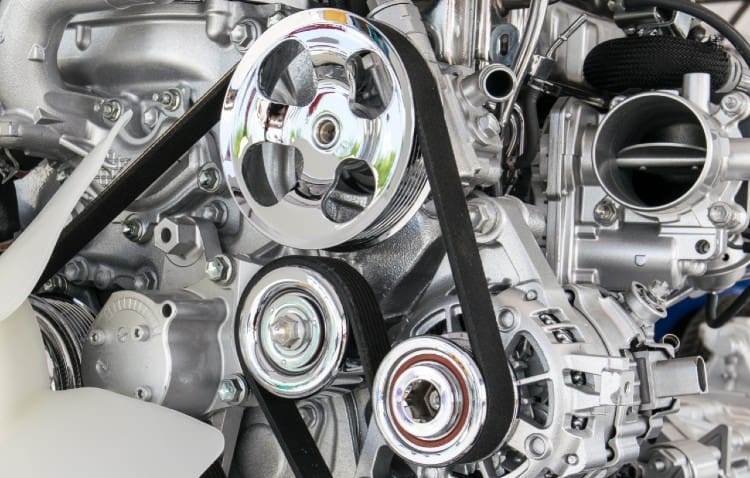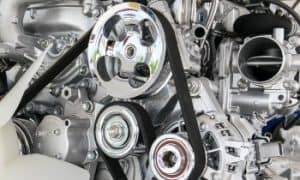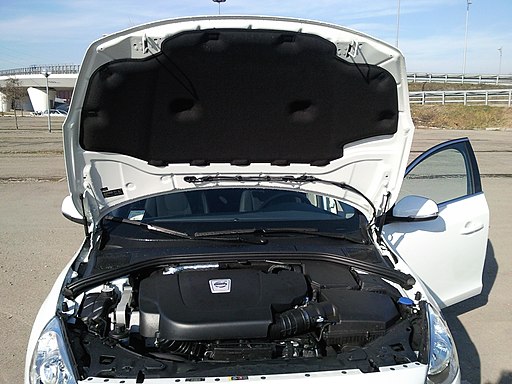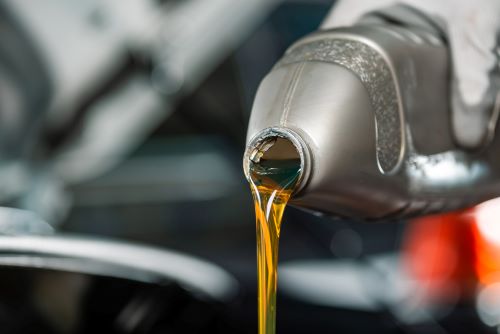Have you ever started a vehicle, and the engine squeaks? Or turned the wheel and it squeals in protest? Aside from being embarrassing, it usually is an indication that something isn’t right under the hood. If you want to know how to make a serpentine belt stop squeaking or squealing, we’ve got the answers.
How to make serpentine belt stop squeaking? Open the hood and inspect the serpentine belt for wear and damage, and its tension. If the belt seems fine, start the engine and squirt the ribbed side of the belt with some water. Listen to the sound; the noise will identify if it is the belt tension, a misaligned pulley, or a failing pump or motor. Fix the underlying problem and replace the belt if it is worn or damaged to stop the squeaking.
In this article, I’ll explain what the serpentine belt is and does. We’ll take a look at what can cause it to make different noises, and what those different noises may mean. I’ll explain what you can do to stop the squeal, and also look at the cost of its repairing or replacing. By the end, you’ll know how to diagnose potential belt concerns, and understand how to maintain and repair the belt.
For more information on automotive soundproofing solutions and techniques please see the following articles:
How to Soundproof a Noisy Water Pump
How to Quiet Noisy Strut Mounts

What Is a Serpentine Belt and What Does it Do?
The serpentine belt is a continuous flat rubber loop that is used to drive multiple components of a vehicle engine. The inside face has grooves or ribs that help it maintain location and increase drive friction. The back of the belt is usually smooth. It does the tasks that used to require multiple belts.
In most automobiles before 1990, there were commonly two or more V-shaped belts used to drive different devices on an engine. The belts would drive the water pump, alternator, power steering, air conditioning compressor, air pump, and other devices different models may have had. The different belts were all driven by the driveshaft and required more space and hardware.
The belt is driven by the driveshaft and loops around the various devices. To maintain contact to drive each component, idler pulleys or belt tensioner redirect the belt and keep it tight. The belt drives all auxiliary functions of an automobile – power steering pump, alternator, air conditioning, water pump, plus others.
Most Common Causes of Serpentine Belt Noise
A serpentine belt drives the auxiliary functions of your car. It charges your battery and operates the pumps for power steering, air conditioner, and often the coolant system too. The belt has a nominal life expectancy between 50 and 100 thousand miles. However, it can fail before then if improperly maintained or due to environmental extremes.
A new squeak or squeal from under the hood could indicate that there is a problem with the serpentine belt. It may mean that the belt is slipping, has become misaligned, or has reached the end of its life. It could also mean there is a faulty pulley or auxiliary device. How often and when the noise occurs provides more information about the cause. Here are some potential causes and what to look and listen for:
1. Wear and Tear
The belt may stretch with age and wear, causing it to slip on a pulley or two and making it squeak. There may be wear or damage to the ribs or grooves of the belt, which will impede friction and cause noise. Additionally, the edges of the belt may also show damage or wear too.
2. Misaligned Pulley or Tensioner
Misalignment can cause the belt to slip or wear unevenly or give the back a hard glazed look and feel. It can also put more or less pressure or drive friction on different auxiliary functions. It could lead to a low battery charge, an overheating engine, less power steering assistance, or poor air conditioner performance.
3. Improper Belt Installation
An improperly installed belt may still operate all or most mechanical and electrical functions powered by the drive shaft. However, the curvature over some pulleys or wheels may be incorrect and cause a squeaky belt. Check the owner’s manual and ensure the installation matches the diagram. An improperly installed belt affects belt tension and can damage pumps, motors, and brackets, leading to more expensive repairs.
4. Weather conditions
Temperature and moisture can cause the belt to be noisy too. Squeaks that only occur when there is an early morning dew or heavy fog means there is moisture on the belt. It should disappear as the engine warms up. Cold temperatures will stiffen the rubber in the belt, causing it to make a noise on start-up. As the engine warms and the belt moves, the sound should go away.
5. Oil or Grease Contamination
If the back (non-ribbed side) of the belt looks shiny or glazed, it can mean there is some contaminant on the belt. Check for coolant, oil, or grease spills or leaks that may get on the belt. The contaminants can deteriorate the belt material and interfere with its operation. It may also indicate other concerns under the hood like a leak, or a pulley or tensioner is out of alignment, seized, or damaged.
6. Defective Bearing
A defective bearing will also squeal, so don’t presume it is the belt. Open the hood and listen to the sound. If you can isolate it to one mechanical location, it may be a bearing. Shut the engine off and check the pulley or wheel where the sound emanated from. If the metal surface is glazed or has belt particles on it, it is probably seized. If it doesn’t spin freely, the component should be replaced.
How to Diagnose Belt Squeal
A squeaky belt can indicate several different issues. If the noise only occurs when turning, starting the engine, or accelerating, it probably is a worn or loose belt. A constant squeal may mean the tensioner system or a pulley is damaged. Diagnosing the sound is the first step in how to make a serpentine belt stop squealing.
While the engine is off, pop the hood and check the belt for wear. Adjust the belt tension if necessary, and check the alignment of the pulleys as well. With the engine still off, identify a safe location where you can spray water from an atomizer onto the top and bottom of the belt. It should be close to where it runs onto a pulley.
Safety Note: Jewelry, loose clothing, and hair are dangerous when combined with moving engine parts. Dress accordingly and wear safety glasses or goggles.
1. Check the Belt for Wear
Visually and physically inspect the belt for cracks in the rubber, which can happen as the belt ages. With age, the rubber may become thinner or have longitudinal cracks or splits. Observe if there are signs of wear at the edges of the belt, which indicates it is misaligned or a pulley is warped or failing.
Check the inside or ribbed side of the belt for damaged or missing rubber, and the overall thickness of the belt. A worn belt is thinner than a new one. Use a belt gauge to check the groove depths; they get deeper as they wear.
Observe if there are hard shiny or wet areas that could indicate leaks or contamination by coolants or other chemicals. A damaged belt may indicate other issues with the engine or auxiliary components. Repair the cause and replace the damaged belt.
2. Adjust the Tensioner
Check the tension of the belt. If you can push the belt inward more than 1/2″ between the pulleys, it needs to be tightened. Alternatively, if you can twist the belt more than 1/2 way over, it’s too loose.
Tensioners are hydraulic, spring-loaded, or manually adjustable. If it has an adjustment bolt, it can be manually adjusted.
Review the owner’s manual for your vehicle specs. Loosen the belt pivot bolt and the adjustment lock bolt; they are often located on the alternator. Slowly tighten the adjustment bolt until the belt has the recommended tension.
Note that when you tighten the adjustment lock bolt and the pivot bolt after adjusting, the belt may tighten a bit more. Check the tension again after all bolts are tightened.
A belt may stretch over time and becomes loose, or the belt tensioner or a pulley becomes loose, misaligned, or damaged. If the belt can’t be tightened anymore or becomes loose again, the tensioner and belt may both need to be replaced.
3. Check the Pulley Alignment
The serpentine belt and pulley alignment go hand-in-hand. The alignment of the belt relies on the pulleys being aligned. If the grooves in the pulleys aren’t aligned, noise will occur, and the belt and auxiliary components can be damaged. Excessive belt wear or damage often indicates a misalignment.
Use a laser alignment tool, a straight edge, or reverse the belt to check alignment. Pulleys should be parallel horizontally and vertically. Alternatively, remove the belt, flip it 180°, and reinstall. Start the engine and listen.
The belt is reversed, and the squeak will temporarily cease or be reduced, meaning the pulleys are misaligned. If the noise is the same, it’s not caused by a misalignment.
Pulleys and shafts should be parallel with each other, and all have the same angle. Pulleys can have a vertical or horizontal angle misalignment caused by an over-tight belt or an improperly placed or loose attachment. A parallel misalignment may mean a pulley has slipped on its axil, or a component needs to be moved forward or back.
4. Check the Pulleys
Loosen or remove the belt to check the bearings of pulleys and attachments. The pulleys should spin freely and quietly. If there is a grinding sound or friction, the bearings are worn or damaged and should be replaced.
Mark the face or edge of the pulley with chalk or a grease pencil and reattach and tighten the belt. Start the engine and drop it into a slow idle. If the mark and the noise seem to align, you have a damaged bearing.
5. Spray the Belt with Water – A 5-Minute Diagnostic
Noise caused by a worn or loose belt can be checked with a water test after doing a visual inspection. Turn the engine on, kick it to a low idle, and open the hood.
Using a spray bottle or atomizer containing water, squirt a small amount of water onto the ribbed side of the belt just ahead of a pulley. Keep your mouth closed and wear goggles as some water may be thrown back at you.
After spraying the water, listen to the noise. If the belt isn’t worn or damaged, the water test can help narrow down the possible causes of the noise. An increase in the noise means the belt is loose or worn, or both.
A temporary quieting of the noise before it returns to “normal” volume indicates a misaligned pulley or a worn belt – if the belt isn’t worn, then it’s a pulley. If the noise doesn’t change at all, then it’s not a belt issue but a failing auxiliary pump or motor.
A squirt of water on the smooth side of the belt will confirm if the belt is the culprit or not. If there is any change in the noise, then the belt is worn and should be replaced.
6. Remove the Belt
Removing the belt makes it easier to check if the pulleys and bearings are the noisemaker. If everything checks out, turn the engine on. If the noise is present, then it isn’t the serpentine belt or an auxiliary part.
It is the idler pulley, crankshaft pulley, or possibly the water pump. Don’t leave the engine running too long without the belt on, especially if it also drives the water pump that cools the engine.
How to Make a Serpentine Belt Stop Squeaking
A squeaky serpentine belt may indicate a worn, damaged, stretched, or loose belt. It may warn of pulley damage or alignment concerns, or issues with other engine components. There are different ways to stop it from squeaking – some temporary and others more permanent.
1. Apply Belt Squeal Spray (Dressing)
 Different spray-on compounds claim to quiet belt noise. The aerosol belt dressings and conditioners are sprayed onto the ribbed side of the belt and may improve friction.
Different spray-on compounds claim to quiet belt noise. The aerosol belt dressings and conditioners are sprayed onto the ribbed side of the belt and may improve friction.
They claim to improve belt life and may remove contaminants and water. The liquids are flammable and cause eye or skin irritation, and are poisonous, so keep your face out of the spray path off the belt and wear safety goggles.
Most belt dressing sprays have a lubricant or a tacky agent in them. The chemicals may make the rubber suppler while making it slip or stretch. Additionally, the compounds can also cause the belt layers to separate. They are quick, temporary solutions and mask the problem, not fix it.
Can You Spray WD40 on Serpentine Belt?
WD40 helps to remove moisture from metal. However, the rubber compounds in the belt can be damaged by WD40. It may quiet the noise temporarily, or make it worse. It can also damage bearings, wiring, and other engine components.
2. Fix a Squeaky Belt With Bar Soap
A squeaky belt may be a loose belt, or there may be dirt, oil, or grease on a pulley causing the belt to slip. Bar soap applied to the ribbed side of the belt may quiet the noise in the short-haul, or make it louder. If the pulleys are dirty, it’s better to find out how they became dirty, fix that problem, and then clean the pulley with an approved solvent.
3. Tighten or Aligning the Belt
Check the alignment of the belt and pulleys, and the tautness of the belt. Tightening the belt may be all that is needed to stop the noise. If there is a misalignment, make the adjustments and tighten the belt. This is a long term fix if done correctly.
4. Replace the Belt
A worn or damaged belt should be replaced after misalignments, or faulty components have been repaired or replaced. A belt that is past its life expectancy may still look good, but if the engine is noisy, replace it.
5. Repair or Replace Defective Bearing
After diagnosing the noise from your engine and identifying it as a defective bearing, decide whether to fix it yourself, or take it to a mechanic. A bearing replacement provides a long-term fix, provided it’s done properly.
Serpentine Belt Repair and Cost
The cost of a serpentine belt depends on the make, model, and year of the automobile. A new belt will cost between $30 and $75 or more. Some models require the tensioner to be replaced with the belt, which adds $40 to $70. If you do it yourself, you’ll save the shop charges, which range from $125 to $225 an hour in my area.
If doing it yourself, take a picture of the belt configuration before removing it. Check the manual for comparison and also belt tension and nut torque values. It may take a pro 20 minutes; give yourself two to four hours, especially if it’s your only means of transportation.
Conclusion
The serpentine belt is a vital part of your driving enjoyment. It powers the air conditioning, power steering, alternator, and even the water pump on some models. If it starts to make noise, it’s best to take notice and fix whatever is causing the problem.
I hope you have a better idea of how to make a serpentine belt stop squeaking. Knowing what it does and what different sounds can mean is a good start in car maintenance. The 5-minute diagnostic will help too.
Whether you choose to maintain and repair it yourself or hire someone else to do it, you’ll at least know if it’s done right. If you found the article of value, pass it on. Your suggestions and comments are appreciated too.
Related posts:





Thank You Eugene! Very well and understandably written article! It made me realize “just wanting to get rid of the squeak”, is far from enough.